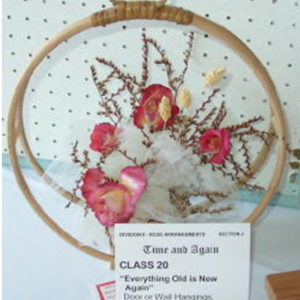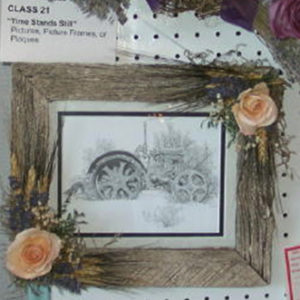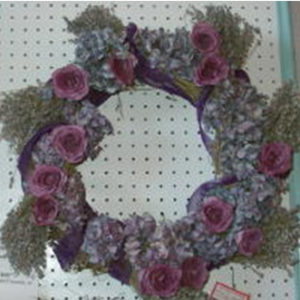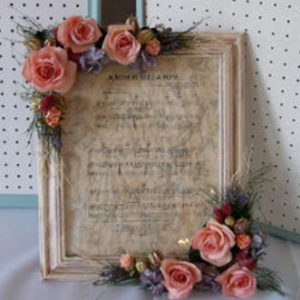Rose Arranging
Various Arrangement of Roses
Click on the buttons to the left to read articles written by TCRS members on arranging with roses. Photos of various classes of arrangements are online.
Rose Arranging 101(or Rose Arranging for Dummies)
by JoAnn Brehm, ARS Accredited Arrangement Judge and TCRS Member
You CAN learn how to make a beautiful arrangement in just a few steps and your society rose arrangers are here to help. A different arrangement will be feathered each month by our arrangers who will guide you through the basic steps and tell you their secrets to a successful design. By June, you will know how to create at least six different types of arrangements and we sincerely hope that you will try at least one for the show. So clip these articles out and keep them handy to practice as your garden starts to bloom this spring.
First, an introduction of arrangement types and basics that you can use no matter what type of arrangement you make.
Traditional Arrangements (Line, Line-Mass, and Mass) – Grand dames of arrangements that have been around for hundreds of years. Think of Queen Victoria, European mansions, and Early America.
Modern Arrangements (Modern and Abstract) – Newer, sleeker styles of arrangements that have developed during the last 40 to 50 years. Think of Frank Lloyd Wright, Picasso, glass and steel skyscrapers, and the space age.
Oriental Manner (Low Container and Tall Container) – Mysterious, simple yet elegant, ritualistic arrangements introduced during the past century. Think of a Japanese garden, a flowing stream, and bringing nature inside.
Miniature Arrangements – Petite versions of the above arrangements. Think of reducing the big arrangements down to a size less than 10 inches using a copier. Everything is in the same proportion, yet much smaller.
All you need is a sense of design, patience, and a little knowledge to create your own design. You already have a sense of design since you’ve seen arrangements at shows, know what is pleasing to you, and in most instances know why certain arrangements win even though you may not be able to express it in words. Also, you have patience (you baby your roses all year to watch them bloom for only a few days). Lastly, we are going to give you the knowledge: simple step-by-step instructions to create your own arrangements.
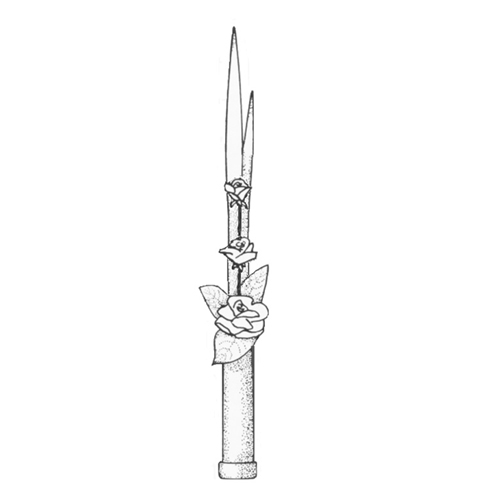 Three important elements in every design are ones you learned way back in preschool: color, line, and size. Remember your assortment of color crayons that you used to draw various shapes and sizes of lines; straight lines, circles, triangles, curvy lines, and just plain scribbles dancing all over the page? That’s it! You now know enough to get going on your own design. First, prepare your materials, then use the following steps to put your design together.
Three important elements in every design are ones you learned way back in preschool: color, line, and size. Remember your assortment of color crayons that you used to draw various shapes and sizes of lines; straight lines, circles, triangles, curvy lines, and just plain scribbles dancing all over the page? That’s it! You now know enough to get going on your own design. First, prepare your materials, then use the following steps to put your design together.
Materials for a Line Design or a Line-Mass Design
- tall, simple container (vase) – earth-tone color or black
oasis soaked until wet – cut to the size of the vase - 2 fresh iris leaves, called line material, both 1.5 to 2 times the width plus the height of vase plus amount to be in a vase.
- 3 roses (for Line, 1 tall stem bud, 1 medium stem more open bloom,
- 1 shorter stem fully open bloom) or 7 (for Line-Mass, various stages) – fresh, groomed, all same rose or similar, rose color compatible with vase color
- 3 hosta leaves (for Line) or 5 (for Line-Mass) – fresh, groomed
rose foliage, or similar foliage, called filler material (for Line-Mass)
pruners to cut plant material, water to fill the vase
Steps for Creating a Line Design
- Place wet oasis into the vase, turn front towards you.
- Cut 3 inches off the bottom of one line material (iris leaf), place both together in the back center of the oasis, pull the top of shorter leaf about 1 inch away from the other (to either side).
- Cut tall stem bud to 1/2 to 2/3 length of line material plus an amount to be in vase, place into an oasis in front of iris.
- Cut more open bloom to length to fit in front of and lower than bud, place into an oasis in front of bud.
- Cut open bloom to length to fit in front of and lower than second bloom, place into oasis in front of second bloom ~ 1 to 2 inches above lip of vase. Line material and blooms should be one in front of the other as they face you.
- Place hosta leaves in oasis, around lip of vase to create focal point around open bloom and hide oasis (in back too).
Steps for Creating a Line-Mass Design In addition to the above steps
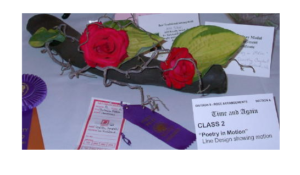
1. When adding the 3 main roses, add additional roses to the sides of the three main roses and lower than the highest bud, generally smaller ones near the top bud and larger ones near the open bloom focal point. If oasis is above the lip of the vase some roses can angle down below focal point. A diamond effect is pleasing.
2. Add additional filler material to loosely fill in the area around the roses, add additional hosta leaves if desired.
Here is a example from the TCRS 2000 Rose Show in Class 2 “Poetry in Motion”: Line Design showing motion.
ROSE ARRANGING – In the Oriental Manner
by JoAnne Brehm, ARS Accredited Arrangement Judge and TCRS Member
This year’s rose show schedule includes two sections for arrangements In the Oriental Manner. The section for large roses has one class for using a low container, typically called Moribana, and one for using tall container, typically called Nageire. The section for miniature roses has two classes in which either container type can be used. To start, some similarities between Moribana (low container) and Nageire (tall container) design are:
– 3 main lines – Heaven, Man, and Earth; the heaven line is about 1.5 to 3 times as long as height plus width of the vase (plus amount in vase); the Man line is about 2/3 to 3/4 the length of the Heaven line (plus amount in vase ); the Earth line is about 1/3 to 1/2 the length of the Heaven line (plus amount in vase)
– 3 main lines form an asymmetrical (irregular) triangle – no matter where you look at he design, from the top or from any side, the tips of the 3 main lines form a triangle where no tow sides are the same length
– supports lines can be used in addition to the 3 main lines, usually made up of individual flowers
– plant material is placed to follow natural growth habits, simple construction, restraint in the use of plant material
Materials for a Moribana (low container) or a Nageire (tall container) Arrangement
- simple, shallow container or bowl (round, rectangular, oval, or square) for Moribana – solid earth tone color or black OR simple tall container for Nageire – solid earth tone color or black
- 1 needlepoint holder and florist putty for Moribana OR oasis soaked until wet, cut to size, and wire for Nageire
- 3 small tree branches (cut as described about for Heaven, Man, and Earth lines) – Japanese maple, cherry, crabapple
- 3 roses used for support lines – approximately 1/2 to 2/3 open, fresh, groomed, all the same, or similar in color, rose color compatible with container color
- pruners to cut plant material, water to fill the container, pebbles are optional for Moribana
Steps for Creating a Moribana (low container) Arrangement
- Place florist putty on needlepoint holder and place til on the left side, either front of back of the container.
- Place Heaven line in erect position in the needlepoint holder, tilted a couple of inches to the left and front of center.
- Place man line in the holder behind Heaven line and then slant it about 30 degrees to the back left.
- Place Earth line in the holder to the right of the Heaven and Man lines and slant it about 70 degrees to the front right.
- Cut one rose to about 1/3 of the Heaven line length and place it in the holder between the Heaven and Earth lines slanting slightly to the front.
- Cut the other two roses somewhat shorter than the first rose, place them in front of the first rose, and slant them slightly to the front.
- Add optional pebbles around needlepoint holder (holder does not need to be completely hidden for Moribana arrangement), fill container wither water.
Steps for Creating a Nageire (tall container) Arrangement
- Place wet oasis in container, use wire to stabilize branches by wrapping them together if needed.
- Perform steps 2-7 as for Moribana design, using the diagram as a guide for positioning lines and 2-3 roses.
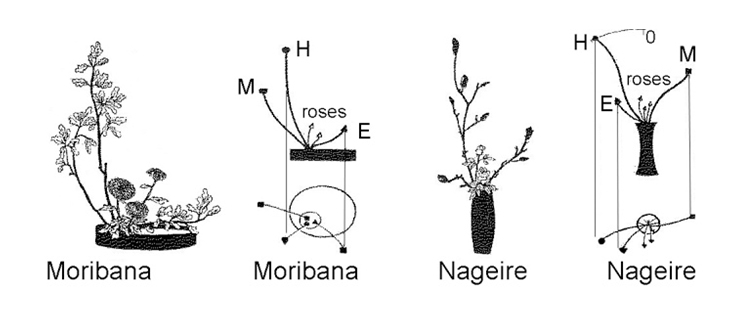
Here are 2 examples from the TCRS 2000 Rose Show in Class 7 “Moonglow”:Design in the Oriental Manner using a low container.
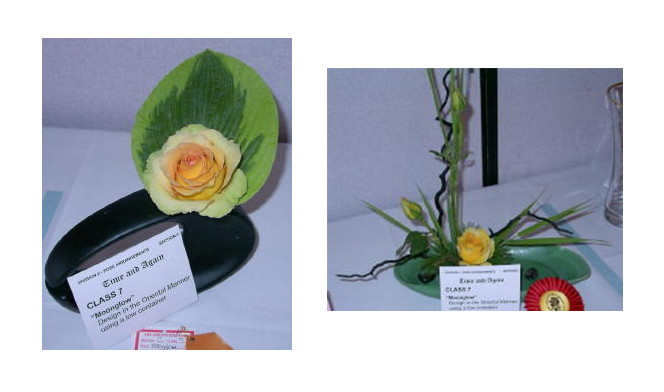
A photo of a entry in the TCRS 2001 Rose Show in ‘Moonglow’:Design in the Oriental Manner.
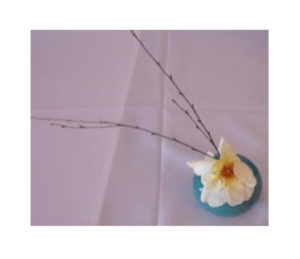
Rose Arranging 101 – Modern Arrangements
Jane Melville, ARS Accredited Arrangement Judge and TCRS Member
Modern or “creative” designs are related to all other designs by definition. In any design, one organizes floral materials to obtain an arrangement of beauty, harmony, distinction, and expressiveness. The traditional design can be used as a foundation for the modern design. The traditional design uses traditional containers with flowers placed by size and color, the largest size nearer the center or “focal point”, and the more intense colors placed within the framework of t he design. The smaller-sized flowers and lighter-colored flowers are place beyond the framework (outside) of the focal point. There is a signal focal point in the arrangement and filler material issued to fill out the contours of the design.
Modern design is eclectic; it combines different styles, colors, and materials. Space is incorporated in the design by placement of the materials used. There may be more than one focal point or center of interest and filler material is not used, as the basic line design is most important. Plant material may be trimmed, bent, clipped, twisted, or folded to obtain different shapes. Fresh plant material may never by colored or dyed but dried material that is colored or dyed is often u sed.
The best way to see this is by looking at two examples as shown below. In the line design, by altering treatment of the leaves an placement of the flowers, it changes from a traditional to a modern design. In the line-mass design, using he same conta iner and some of the same materials, the design is changed by using purple (or any color you like) painted dried branches. By tying knots into the leaves and by having two focal pints, it becomes a modern design.
The usual rules of size of the design in relation to the size of the container still apply. Whichever is largest – height or width – of the container, a rule of thumb is 1.5 to 3 times that measurement. A 12 inch container requires a minimum of 18 inches and a maximum of 36 inches in height. Light, airy material and fine grasses used for your line can reach to 3 times, while more visually heavy flowers, branches, etc. should be closer to 1.5 times. Step back and squint your eyes; does it look to short and squat or too top heavy? Vary your placement until it looks balanced.
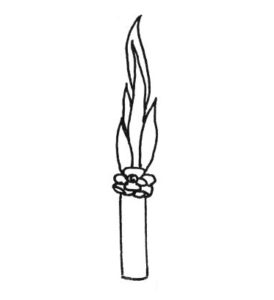
Traditional Line
- Single focal point
- Natural use of flowers and foliage
- Larger flower close to container
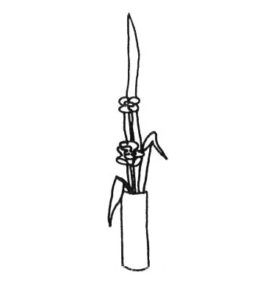
Modern Line
- Folded Leaves
- Flowers placed up and away from container lip
- Two focal areas
- May use unusual containers
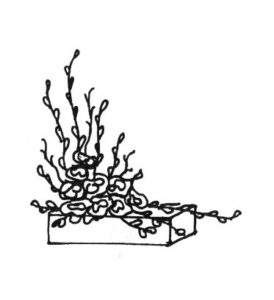
Traditional Line Mass
- Single focal point
- Use of filler material
- Natural use of flowers and foliage
- Larger flowers close to container
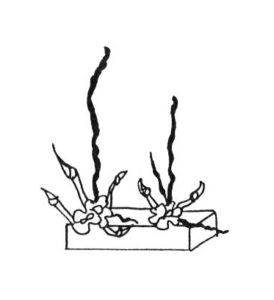
Modern Line-Mass
- Dried branches e.g. painted purple
- Enclosed space or opened areas
- Knots tied in leaves
- Two focal areas
- e.g. Hot pink colored flowers for contrast with purple branches
- May use unusal conatiners
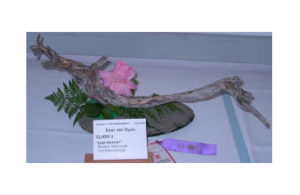
Above is an example from the TCRS 2000 show of Class 5 “Lost Horizon”: Modern Horizontal Line-Mass Design.
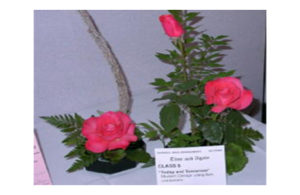
Above is an example from the TCRS 2000 show of Class 6 “Today and Tomorrow”: Modern Design using two containers.
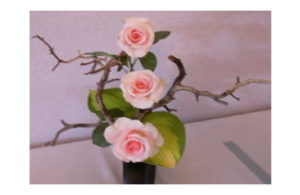
Photo of an example from the TCRS 2001 show of “The Twist”: Modern Design
Rose Traditional Mass Arrangements
by Dorothy Campbell, ARS Accredited Arrangement Judge and TCRS Member
The mass arrangement is characterized by large quantities of plant material in a full, but not crowded design. The structural lines are not as clearly defined as in line and line-mass arrangements. The strongest line, top and auxiliary lines on the sides serve to lead to eye of the viewer to the focal area near the rim of the container. Mass arrangements are usually either a symmetrical or asymmetrical triangle or oval in form.
Colors are grouped with the darker colors and larger flowers near the lower center of the design and the lighter colors and smaller flowers forms towards the top and sides. Mass arrangements have become more free flowing in placement of plant material with restraint in the number of flowers used so that each bloom has space to accentuate is own beauty.
Characteristics of traditional mass arrangements are :
- A closed silhouette (outline of design in space around it)
- Abundance of plant material arranged in an orderly pattern, not crowded
- Colors and forms are grouped for visual balance and rhythm
- Has well developed focal area
- Gradation in color (light to dark) and in size of forms (small to large)
In a mass design you want the flow of the plant material to carry your eye through the design, with the main focal point being in front and close to the rim of your vase. The mass arrangement is my all time favorite. I love the freedom of choosing se veral different types of flowers to compliment my roses and to be able to choose many different colors and sizes and shapes and textures.
To get started:
- Choose a container that is pleasing to you. Keep in mind its height and width in conjunction with the flowers you will be using.
- Next, decide what roses you are going to use and remember that in all rose show arrangements, the “ROSE” always needs to be the dominate flower.
- Now choose what filler flowers you are going to sue. If you grow lots of annuals and perennials it helps a lot. It is also great if you have neighbors with a nice cutting garden and they allow you to pick to your hearts content.
- Good filler flowers which are easily grown in our area include: Salvia, Cosmos, Larkspur, Statice, Asters, Veronica, Coreopsis, a variety of daisy, baby’s breath, astilbe, and hostas just to name a few.
Follow the simple step by step examples shown below and remember the most important thing is to have fun and enjoy what your are creating.
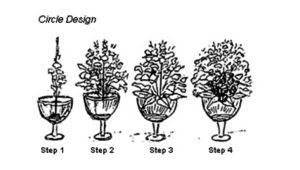
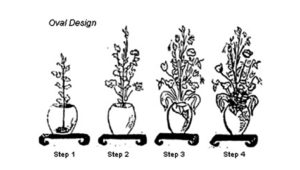
Here are some examples of Traditional Mass Designs from the 2000 TCRS Rose Show:
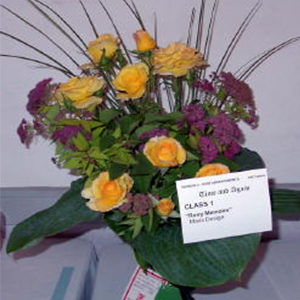
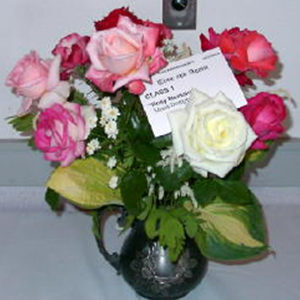
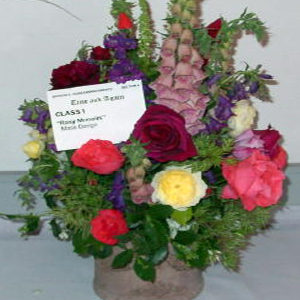
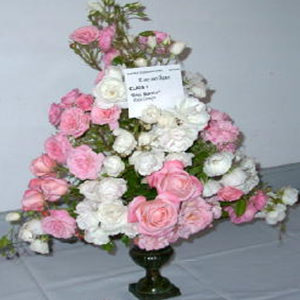
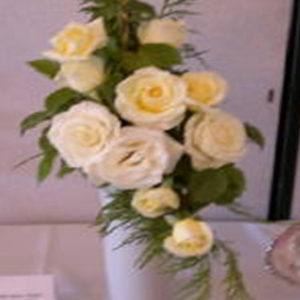
Rose Arranging 101 – Miniature Rose Arrangements by Linda Kerkof, ARS Accredited Arrangement Judge and TCRS Member
Miniature arrangements are executed solely with miniature roses and are limited to 10 inches in height, width, and depth. This is the only arrangement category that limits the type of rose, miniature, to be used in a design. All miniature arrangements are judged at eye level.
Miniature designs are works of floral art just as standard arrangements. They may be traditional line, line-mass, mass, any type of modern, any type in the Oriental manner, dried, or even table arrangements. The show schedule will tell you what type of design, any restrictions, and the size of the design. Size range can be, “no less than 3 inches, and no more than 5 inches”, or “no more than 10 inches in height, width, and depth”. All roses must be correctly named and outdoor garden grown to be eli gible for an American Rose Society (ARS) award. If the roses are grown by the arranger, and “arranger grown” or “AG” is marked on the entry tag, then the arrangement can be considered further for an ARS medal certificate.
Other plant material be used in the design, but remember the rose bust be the dominant flower and other plant material bust be in line with the size of the design. Proportion and scale are the two principals of design that will cause you the most conc ern, as they are more noticeable in a miniature design. You need to take into consideration the size the design calls for, the size of your container, the size of the roses you use, and the size of the subordinate flowers you use in the design. Always r emember to check the roses in your design for perfection, color, substance, and overall beauty. The need to be in peak condition and good proportion and scale.
Listed below are a few designs to help you the scale and size in check. Try these designs. They don’t take up a lot of room in your home and you can get lots of practice before the rose show.
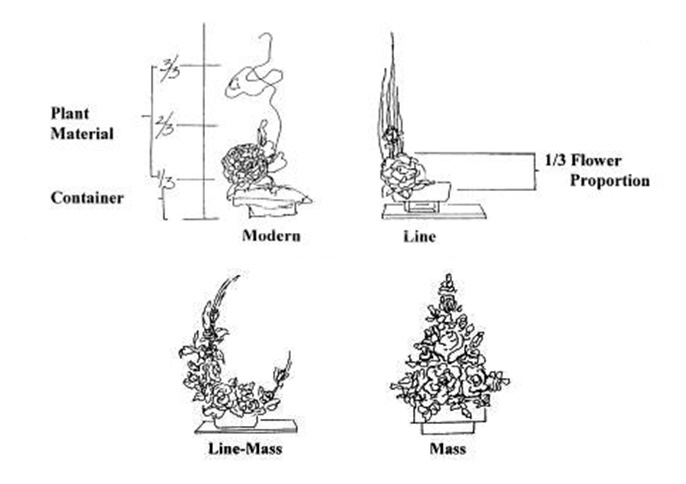
Here are some examples of Miniature Arrangements from the TCRS 2000 and 2001 Rose Shows:
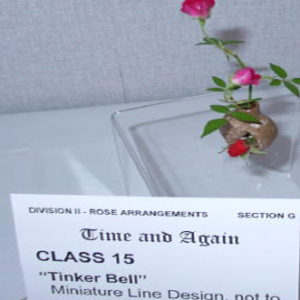
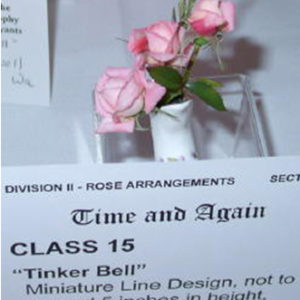
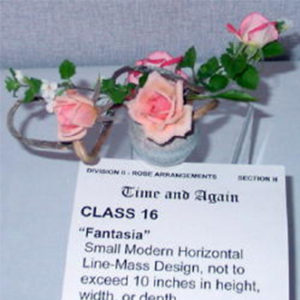
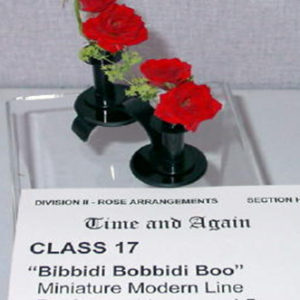
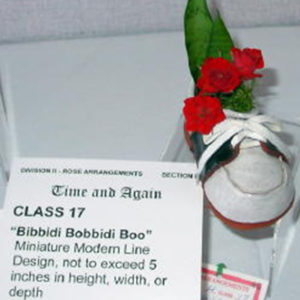
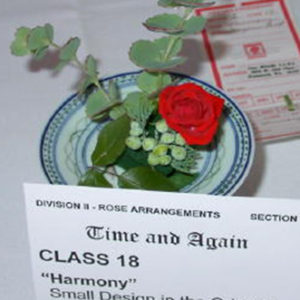
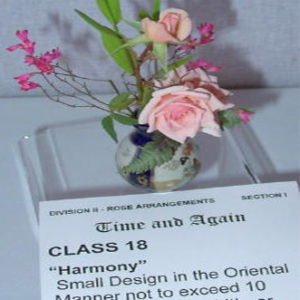
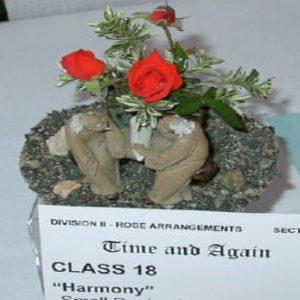
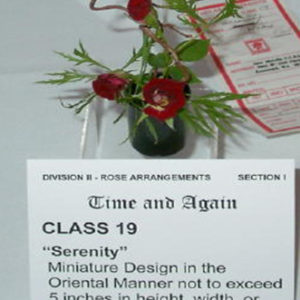
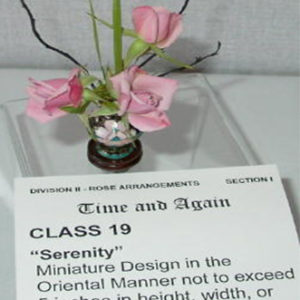
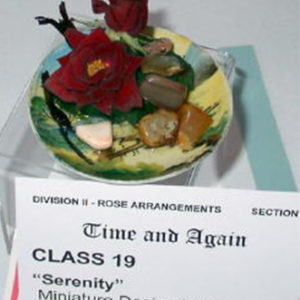
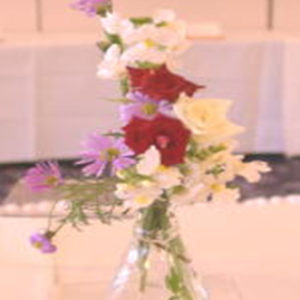
Here are some examples of arrangements using dried roses from the 2000 TCRS Rose Show
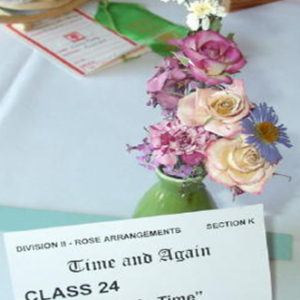
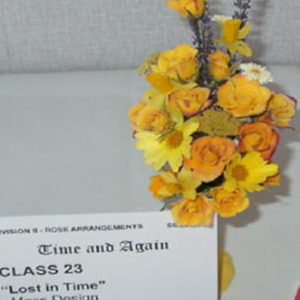
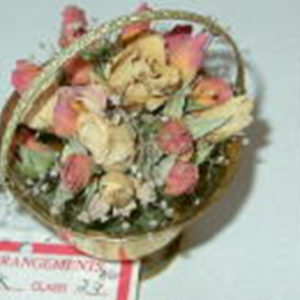
Here are some examples of Rosecrafts from the 2000 TCRS Rose Show:
